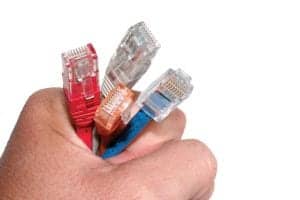
Questions about types of cable and cable connectors may be on the CBET test.
If you desire to become a certified biomedical equipment technician (CBET), I certainly hope by now you have visited the AAMI Web site and read the material provided. Here you will find the five areas of knowledge you must possess and what percentage of the 150 questions are in each category. When you visit this site, you will see the question categories are labeled as Anatomy and Physiology, Public Safety, Electricity/Electronics, Medical Equipment Function, and Medical Equipment Problem Solving. The one area that is obviously missing is networking. As networking technologies have propagated throughout our society, it has also found a home in health care. Health care technology personnel such as BMETs must have some knowledge of networking to function in today’s health care delivery system. As mentioned, there is no category for networking unless you wanted to throw it in equipment function or possibly problem solving. But do not think that since there is no category for networking you will not see questions in the realm of IT or networking.
This installment of ICC Prep will go over some areas where BMETs may be involved in networking technologies and begin to explore possible questions that may appear on the CBET exam. We will take a little more technical look into today’s health care networks.
Today there are numerous medical systems that are connected together via networks. These networks may be inside a medical facility, outside a medical facility, or both. These networks are joined by a device known as a router—an electronic device that interconnects two or more computer networks and selectively interchanges packets of data between them.
Let’s begin by identifying some basic types of networks. A local-area network (LAN) consists of connecting devices over a short distance. An example would be connecting vital sign monitors in patient rooms to the central monitoring room or nurse stations located on or very near the same floor. Because a LAN covers only a localized area it provides high data transfer rates that enable several devices, such as monitors, to send critical data much more quickly to the central monitoring rooms or nurse stations.
The other major type of network is the wide area network (WAN), which covers a wide geographic area. An example of a WAN would involve having remote offices of a medical facility view radiographic images from other cities or countries. Unlike a LAN, a WAN is not limited to a network within a hospital building, and it can cover distances around the globe. LAN and WAN networks have the ability to connect devices to them without cables, or wirelessly.
A question or two will more than likely refer to network topologies. Be familiar with the different types of network topologies such as bus, star, mesh, ring, and hierarchical, and the advantages and disadvantages of each.
Each refers to the overall shape of the network configuration, which is designed for optimum performance by a network engineer. Most of today’s topologies are a blend of these basic formations.
Connected Subnets
Today’s typical hospital network is a set of connected subnets connected with routers. In a medical facility, an example of a subnet could be a LAN. An Intranet consists of a set of nodes or systems connected to each other within a local segment. A node is a term used to identify a device or computer connected to the network. Each node or computer must have a network interface card (NIC), which is a hardware device that handles an interface to a computer network and allows a network-capable device to access that network. The NIC has a ROM chip that contains a unique number—the media access control (MAC) address—burned into it. The MAC address identifies the device uniquely, meaning all computers connected to any network can be easily identified by the unique MAC address.
Cables and Connectors

Be familiar with the different types of network topologies such as bus, star, mesh, ring, and hierarchical, and the advantages and disadvantages of each.
So, how are medical devices networked in medical facilities? A great example would be networking physiological monitoring systems in intensive care rooms to the central monitor. This is done by plugging the ICU room monitoring system into the medical facility’s LAN via an Ethernet cable, which is referred to as a CAT 5 cable, or the newer CAT 5 cable, which is a CAT 6 cable. A CAT 6 cable is essentially CAT 5 but is shielded. Types of cable and cable connectors are possible CBET questions. The standard CAT 5 cable is connected with what is known as a RJ-45 connector, much like a standard telephone connector but larger in size. Standard telephone connectors are RJ-11-type connectors; this has been reported as a CBET question.
In today’s networked health care system you may run into a scenario such as this: A nurse may call and report the patient monitoring data just dropped off the central monitor. Upon troubleshooting, do not always assume it is a network problem. First, go to the patient’s room and observe the monitor to see if it is turned on and functioning properly. If not, then follow normal troubleshooting techniques for that device. If the monitor is functioning properly at the bedside, the next step is to check and see if it is connected to the network. This can be done by accessing settings specific to the manufacturer to view other monitoring devices on the same network. On the CBET exam, this may be referred to as “pinging” another computer. Ping is a computer network administration utility used to test the connectivity of a host on an Internet Protocol (IP) network and to measure the round trip time for messages sent from the originating host to a destination computer. If you find the monitor was not connected to the network, then you may want to check the network cable, and this will hopefully resolve your problem. If your ping command is not recognized and the fault is not wiring or connectors, you may want to consult with your IT department about possible software issues.
Another problem you may encounter with networking is that you have received a monitoring system that has been out for repair and, after installing the unit, you are unable to see it on the central station. First, you may want to access the settings for the monitoring system and input or verify that the correct IP address, MAC address, and node ID numbers are present. Without these numbers, the device cannot connect to the network. The CBET exam may also ask about these definitions, so be familiar with them. The IP address is a series of numbers that are assigned to devices that utilize the Internet. As stated earlier, the MAC address is a unique number assigned to network interfaces that allows devices to communicate with the physical network.
Wireless networks are another area of networking you may see questions about on the exam. These types of networks are typically governed by IEEE 802.x protocols. Wireless networks can involve using light, microwaves, or radio waves to replace wire or fiber optics as the transmission medium for the network. Wireless systems that utilize light, such as fiber optics, provide a high degree of speed and security. Radio frequency (RF) systems utilize low or narrow power spectrum transmission and are susceptible to interference. One thing to keep in mind is each wireless local area network, or WLAN, must have an assigned service set identifier (or SSID) name that will allow all devices on a network to communicate with one another. Wireless devices are susceptible to interference from multiple sources such as RF interference, electromagnetic interference, and other wireless devices such as cell phones. Wireless systems must be secured since they may be vulnerable to unauthorized access. Wi-Fi protected access (WPA) provides encryption and authentication for users to ensure no unauthorized access occurs. Newer encryption methods are being developed all the time and will continue to enhance network security.
Biotelemetry, which utilizes RF, is used to transmit physiological data from the patient to a remote monitoring area. Keep in mind that the radio frequencies used in today’s telemetry networks are dedicated networks and do not use the protocols of IEEE 802.x, as this type of network does not communicate with other IEEE protocol devices.
The telemetry system consists of applying the transmitter leads to electrodes on the patient’s chest. By connecting the leads, the transmitter box can detect and send RF readings to a central antenna, which separates the information received from several other transmitter boxes and sends them to various receiver modules, each specific to a telemetry box. The receiver module is already networked into the main server where telemetry personnel are able to monitor patients’ parameters, such as an EKG, from remote areas.
Some of the common problems associated with these systems include a nurse reporting an EKG waveform is not clear. The first thing you may want to do is ask the nurse to ensure electrodes are making good contact with the patient. The problem may also be due to a bad lead wire, and in rare cases bad electrical grounding of the patient bed, which could cause interference. Another problem may be the telemetry transmitter box is not working. To begin troubleshooting the problem, first change out the battery of the transmitter, and if that does not resolve your problem, you may want to replace it with another telemetry box. If the problem persists, then most likely you need to either reset or replace the receiver module.
There are multiple problems that can occur, but always start by troubleshooting the transmitter box before jumping into network problems. If multiple telemetry boxes were not working within the same vicinity, it is more logical to assume that the main antenna is defective than to assume five transmitter boxes just quit working.
When taking the test, always read CBET questions carefully as subtle hints may be given that will enable you to select the proper answer. Look for common problems rather than rare ones.
John Noblitt, MAEd, CBET, is the BMET program director at Caldwell Community College and Technical Institute, Hudson, NC; and Robert Hijazi, MS, MHA, CBET, is a clinical engineer at Palmetto Health Hospital, Columbia, SC. For more information, contact .
A link to AAMI’s Web site to help biomedical equipment technicians prepare for the CBET: www.aami.org/certification/download/handbook.pdf
Review Questions
- What type of network topology consists of a single central cable through which all computers and devices connect to?
- Bus
- Star
- Mesh
- Ring
- What are RJ-45 connectors used for?
- Connect computers or devices to the Ethernet
- Connect phones together
- Connect phones to computers
- All the above
- What type of network backbone utilizes a LED or laser as a method of data transmission through the cable?
- Microwave
- Radiowave
- Fiber Optic
- All the above
- A series of subnets connected by routers is referred to as a(n)?
- Intranetwork
- Internetwork
- Server
- Node
See the answer
See the answer
See the answer
See the answer



